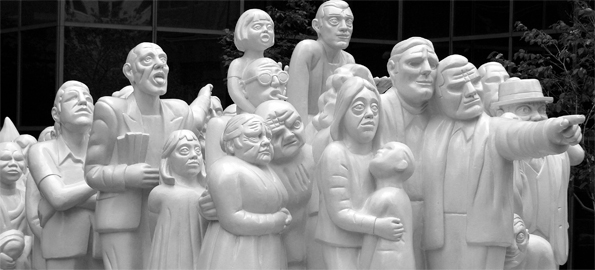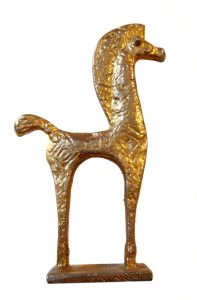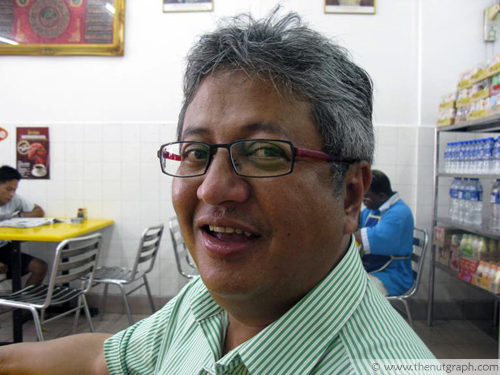
TALK has been rife recently of a “third force” in Malaysian politics. Civil society groups have proposed their own candidates for the 13th general election. Datuk Zaid Ibrahim wants to form a new political party.
But is there room in Malaysian politics for a third force? What would it look like? And why is the idea gaining ground when Malaysia hasn’t even firmly established a two-party system? The Nut Graph asks political scientist Wong Chin Huat in the latest instalment of his column Uncommon Sense.
TNG: What is the third force?
Wong Chin Huat: In a two-party system, the minor parties are called third parties. The term “third force” in Malaysia is often associated with civil society — that is, independent from the two contenders for state power i.e. the ruling coalition and the opposition.
Why is the idea of a third force gaining popularity in Malaysia?
Talk of a third force is getting popular because many citizens are feeling disillusioned with PR. This is not surprising as citizens often become disillusioned with professional politicians in democracies. The Tea Party movement’s rise in the US is an example of popular revolts against the political class. It is also unsurprising that the population abandons once-“heroes” of democratisation after the zest over political transition dissipates. Most democratic opposition parties in former Eastern European communist states, for example, handed back power to their reformed “enemies” (ex-communists repackaged as Social Democrats) after one or two terms in power.
What is surprising is that this disillusionment in Malaysia happened as fast as it did — before PR has even won federal power. PR’s defeat in the Galas and Batu Sapi by-elections was privately characterised by a polling expert, I think aptly, as PR’s and [Datuk Seri] Anwar Ibrahim’s mid-term disaster.
What can explain PR’s rapid decline in popularity? Why can’t PR unite in view of the bigger goal of winning the general election?
PR’s rapid decline is due to its failure to convince Malaysians that it can be really different from BN, notwithstanding remarkable reforms carried out in Penang and Selangor.

A major contributor to the perception that PR is just another bunch of power-crazy politicians is their in-fighting. Perhaps they are over-confident of victory. More likely, they lack confidence so they are fighting a life-and-death battle for whatever they have now. Perhaps they are infiltrated by “Trojan Horses” sent by Umno or BN. More likely, they are simply too trapped in the winner-takes-all mentality so prevalent in Malaysian politics.
Whatever the reasons, the fact is PR no longer captures the imagination of a big segment of the silent majority. Many from this silent majority were politically activated just before, during or after the 8 Mar 2008 general election. They expected the democratisation pathway to be straight and smooth, with clearly defined good characters (PR) and bad characters (BN). Call it innocence lost.
Many of them may just not be bothered to bring themselves to the polling booth in the next general election. Perhaps that’s what BN needs to win back a two-thirds majority, even without the help of constituency redelineation.
What would the third force look like and how big an influence would it have in Malaysian politics?
The third force may take two ultimate forms: as PR’s partners whether from within or without, or as PR’s competitors. To succeed, either form would require the third force to win phenomenal support from the disillusioned or independent middle ground.
If the third force takes a pro-PR form, it must be able to win anti-BN voters disaffected with PR. If they cannot do so, PR will not concede some winnable seats to them at the expense of alienating their own party cadres. And if they want to compete with PR and emerge victorious in three-corner fights, then they need to win over some PR partisans on top of securing the disaffected middle-ground votes.
Whether or not this third force would be able to win over these cynical, “disillusioned” voters and even some PR supporters will depend on whether they can show that they are in a different league. The “disillusioned” bloc is simply too impatient to know who are the good and bad characters in the intra-PR power struggle. These irritated and impatient voters just want different politicians.

In this sense, I doubt Datuk Zaid Ibrahim’s camp will survive better than Berjasa and Hamim, PAS’s splinter parties led by former Kelantan Menteri Besar Datuk Muhammad Nasir and former party president Asri Muda. The failure of SAPP — a party appealing to Sabah nationalism — to even emerge second in Batu Sapi speaks volumes of the nationalisation of Malaysian politics since 2008.
Fresh faces such as non-governmental organisation leaders and public intellectuals who have never joined party politics will also face challenges if they contest in the elections. In urban constituencies which are more receptive to new politicians, they may still not be able to outshine most of the PR incumbents or candidates who are mostly the better halves in the coalition. If they aim at the weaker links in PR or BN, they may find their battlefield in rural areas where strong party machinery is a must and a strong factor in determining election outcome. For example, if fielded in Kinabatangan, would even Raja Petra Kamarudin be confident of victory against Datuk Bung Moktar?
Are Malaysians then held ransom to the two camps if there is no room for a third force?
I am inclined to be more imaginative in defining the third force. Why must it be seen as the third competitor? Why can’t it be the referee to the two competitors?

At the end of the day, what would make the notion of the third force work is the ability to reignite the middle ground’s passion. If voters do not trust politicians now, perhaps energy would be better spent getting them to trust themselves. To see in themselves the ability to change politicians and not just be cynical and bitter.
In this sense, the third force can take the form of organisations and movements such as Bersih 2.0 which is civil society-led, and the anti-100-storey mega tower Facebook page which has 250,000 members but is deliberately leaderless. If Malaysians are eventually strong enough to stop flawed political elections or extravagant architectural erections, the two coalitions will get the message and the third force candidates will eventually find some breathing space.
In the long run, a way for smaller parties or groups of independent candidates to emerge as a check and balance to the dominant parties is to hold local elections with smaller constituencies. The electoral system will also need to be reformed so that some are elected through party list proportional representation. Curiously, this has rarely, if ever, been raised in talks of a third force, not even as a long-term vision. ![]()
Wong Chin Huat is a political scientist by training and a journalism lecturer by trade. If readers have questions and issues they would like Wong to respond to, they are welcome to e-mail editor@thenutgraph.com for our consideration.


Dr Syed Alwi says
Dear People,
Malaysia is a divided nation. The Malays prefer a more Islamic Malaysia, whereas the Chinese and Indian [Malaysians] prefer a Western-style, secular liberal democracy. Neither Ketuanan Melayu/Islam nor Malaysian-Malaysia is inclusive enough to capture these divergent aspirations.
The only way out is a third force that has an ideology that is inclusive of both the Malay and non-Malay aspirations. Here I propose Unity In Diversity as a slogan and ideology to replace the exclusivist Malaysian-Malaysia and Ketuanan Melayu/Islam.
Unity In Diversity means that we do NOT attempt any homegenisation of Malaysia. Instead it recognises the legitimate aspirations of each ethnic group. Unity In Diversity respects the Parliamentary democracy without marginalising any ethnic group.
Regards
Dr Syed Alwi
HaHaHa says
“Unity in diversity” has two basic components :
a. Diversity – which is an inescapable aspect of life, even within a homogeneous culture such as the Islamic fraternity.
b. Unity – which is of the heart and mind. No amount of sloganeering or constitutional amendment can foster this within our own hearts and minds.
Malaysian diversity came through various phases. Before Independence the various ethnic, religious and cultural groups were dependent on one another to win back the country from the British.
After Independence, the various ethnic groups also became independent of each other. Each went their separate way to make a life for themselves. The separation became more pronounced as political parties, particularly Umno, used such diversity as a strategic means to divide and rule. Even to this day it is being played out to the detriment of everyone.
Reality hits home when the nation is facing the prospect of a failed state. Najib had to contend with so many warring factions within Umno that he has to flip-flop between positions, but he and many within Umno began to realise that they can no longer alienate a large segment of the population. Najib, not being able to effect the necessary transformation mental leap, will only lead the nation further into the abyss of economic torment and uncertainty.
Everyone in the country needs to realise that all of our destinies are bound by history and boundaries, and the only way forward is to forge a unity that comes from an awareness of our interdependence. We are running a three-legged race, and the sooner we realise this, the sooner we will be able to celebrate our diversity.
JW Tan says
I find it interesting that you used the Tea Party movement in the US as an example. The Tea Party movement is not in fact a third force as you defined it, but a rejuvenating influence on one of the two main forces. A real third force would be something like the Liberal Democrat party in the UK.
I think a “third force” in Malaysian politics may well take the form of the Tea Party movement, i.e. changing the make-up, ideology and raison d’etre of either PR or BN. It’s more probable that it would be PR, as I think BN is so rotten it barely has an ideology anymore.
HJ Angus says
It is interesting that the “third force” will be offering good/better candidates to PR only, showing that it really has lost all hope of reforming the BN. My opinion is that the “third force” will only confuse voters more, as the BN regime does not even provide a fair exposure of the PR candidates via radio and TV to explain issues to the voters.
stewoolf says
We are climbing up the learning curve, at times painful and confusing; the “third force” is the by-product of such a process. The lesson being learnt now is, political leaders are not holy [persons]. Those of the third force who were close enough to the leadership in power, and those in the opposition, are losing faith in reform within. The lesson needed to be learnt is, no holy [persons] are needed to run the government properly. What is needed is a two-party system that enable checks and balances, independent institutions and non-partisan bureaucrats.